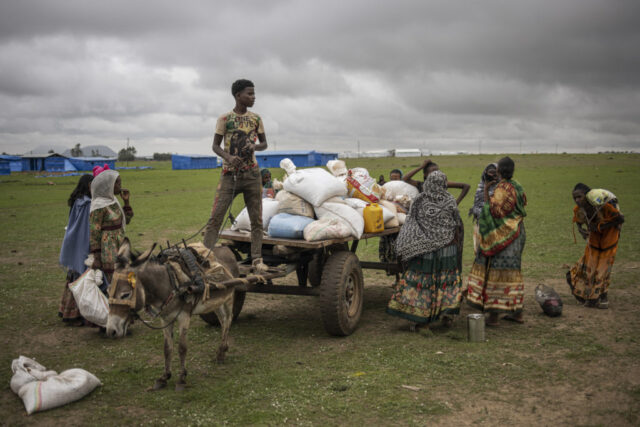The Trump administration’s decision to freeze foreign aid supplies and essentially shutter USAID has had seismic effects on global humanitarian efforts.
The U.N. World Food Program is one of the organizations that has drawn vast portions of their budgets from the U.S. government. Historically, the U.S. has been the agency’s biggest donor by far.
The WFP’s largest network of food distribution is in Ethiopia, a nation that became a byword for famine in the 1980s. There, populations continue to suffer from frequent food shortages with a government that’s often unable to fund emergency support for its own citizens.
In late 2023, PBS NewsHour special correspondent Willem Marx and videographer Edward Kiernan traveled across Ethiopia to understand the role that climate change and conflict were having on food supplies, witnessing first-hand the work that the World Food Program and its partners were conducting to confront such challenges. Even a relatively brief monthslong pause in U.S. funding for food aid had a devastating impact on millions of Ethiopians.
With the current uncertainty of whether the Trump administration will offer waivers that allow emergency food aid to continue in some of the world’s most impoverished places, these three stories from Ethiopia highlight the heavy reliance that many communities have had on U.S. funding.
New farming techniques build food resilience in Ethiopia
Across large parts of Ethiopia, many families rely on subsistence farming for their food needs, and occasionally are able to sell some excess crops for cash that can pay for the other necessities of life. But violent local conflicts as well as climate change often cause farmers to lose crops that supply them with food, which in turn has a drastic impact on their health – and even survival. Aid organizations, including the World Food Program, have been working for years to strengthen food resilience among many Ethiopian communities. They encourage new planting techniques, introduce updated technologies, or teach people about different seed types, pesticide use and storage practices. These interventions help those living in rural villages to increase their crop yields, and thus ensure that external factors in the future cannot so easily wipe out their household wealth, which is largely linked to what they plant and reap. At some Ethiopian schools — built with U.S. money — the World Food Program and its partners run feeding programs — reliant on U.S.-funded supplies — that also seek to strengthen resilience and improve educational outcomes by guaranteeing at least one daily nutritious meal for young children who might otherwise not eat.
Ethiopian farmers drop livestock for drought-resistant crops
Farmers in the Somali region of Ethiopia have traditionally relied on their livestock for their livelihoods. As is the case in many parts of Africa today, they are finding that climate change has started to not only limit access to sufficient quantities of water, but also reduced the availability of grazing for their animals. As temperatures rise and rain levels fluctuate or fall, less grass is growing. Several successive droughts in recent years have killed tens of thousands of cows, goats and sheep, forcing many to reconsider their identity as herders — as a matter of survival. With support from international aid organizations, including the U.N. World Food Program, some ethnic Somali farmers in Ethiopia have been able to transition from cattle herding to crop growing in areas near their homes that – without outside help and funding – might still be desert. Community farming efforts have helped villagers feed the animals that have survived, grow new plants in greater quantities, and earn extra cash at local markets that in turn helps improve living standards. But inconsistent rainfall and flooding still threatens the success of these adaptation projects — but not nearly so much as the loss of substantial American funding.
After years of war, Tigray now faces long wait for food aid
A brutal civil conflict in northern Ethiopia’s Tigray region ended in late 2022, leaving tens of thousands of people dead, but sporadic violence has continued in several parts of the country since. Besides the immediate, deadly consequences in communities devastated by years of violence, limited food supplies and restrictions on aid support during the conflict affected not only Tigray, but neighboring regions like Afar as well. A reliance on foreign aid – much of it financed by the United States through UN agencies like the World Food Program – has been a feature of life for decades in much of Ethiopia, where changing Climatic conditions and conflict have made access to food difficult. But government instability in Tigray also led to widespread corruption and the diversion of foreign food aid, forcing the U.S. government to suspend funding for six months in 2023. The effects were severe in Tigray, Afar and elsewhere in Ethiopia; and at times,were deadly. The current curtailment of U.S. aid has already forced the World Food Program to close its office in South Africa, and threatens many more lives in nations like Ethiopia, where the margins between starvation and survival are already incredibly narrow.
Insightful, trustworthy journalism, for everyone.
Your tax-deductible donation ensures our vital reporting continues to thrive. Support PBS News Hour now while all gifts are MATCHED!

















































